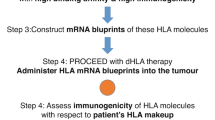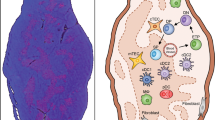Abstract
EXPOSURE to a number of carcinogenic agents results in a depression of immune status1. In detailed studies of chemical carcinogenesis in mice, Stjernswärd2,3 has shown that methylcholanthrene, benzpyrene and dimethylbenzanthracene (DMBA), all potent carcinogens, depress the immune response to sheep red cells (SRBC) for a long period following a single small carcinogenic dose of the agent. Although it seemed likely from these studies that the carcinogens act on the cells involved in the immune response, no direct evidence was presented. Recent work4–10 in a number of independent laboratories clearly demonstrates that a variety of cell-mediated immune responses, including those to SRBC, involve the interaction of two distinct classes of lymphocyte—the thymusderived cell responsible for reacting with antigen and the bone-marrow derived cell that is the precursor of the antibody-forming cell. The present study was designed to show whether carcinogen-induced immunodepression was a phenomenon linked to cells involved in the immune response and, if so, which of the interacting classes of cell was the target for this effect.
This is a preview of subscription content, access via your institution
Access options
Subscribe to this journal
Receive 51 print issues and online access
$199.00 per year
only $3.90 per issue
Buy this article
- Purchase on Springer Link
- Instant access to full article PDF
Prices may be subject to local taxes which are calculated during checkout
Similar content being viewed by others
References
Stjernswärd, J., in The Immune Response and its Suppression (edit. by Sorkin, E.), 213 (Karger, Basel/New York, 1969).
Stjernswärd, J., J. Nat. Cancer Inst., 36, 1189 (1966).
Stjernswärd, J., Cancer Res., 261, 1591 (1966).
Miller, J. F. A. P., and Mitchell, G. F., J. Exp. Med., 128, 801 (1968).
Mitchell, G. F., and Miller, J. F. A. P., J. Exp. Med., 128, 821 (1968).
Nossal, G. J. V., Cunningham, A., Mitchell, G. F., and Miller, J. F. A. P., J. Exp. Med., 128, 839 (1968).
Davies, A. J. S., in Transplantation Reviews (edit. by Moller, G.), 43 (Munksgaard, Copenhagen, 1969).
Claman, H. N., and Chaperon, E. A., in Transplantation Reviews (edit. by Moller, G.), 92 (Munksgaard, Copenhagen, 1969).
Taylor, R. B., in Transplantation Reviews (edit. by Moller, G.), 114 (Munksgaard, Copenhagen, 1969).
Shearer, G. M., and Cudkowicz, G., J. Exp. Med., 129, 935 (1969).
Cunningham, A. J., and Szenberg, A., Immunology, 14, 599 (1968).
Jerne, N. K., and Nordin, A. A., Science, 140, 405 (1963).
Martin, W. J., and Miller, J. F. A. P., J. Exp. Med., 128, 855 (1968).
Author information
Authors and Affiliations
Rights and permissions
About this article
Cite this article
ROWLAND, G., HURD, C. Target Lymphoid Cell Population of Carcinogen Induced Immunodepression in Mice. Nature 227, 167–168 (1970). https://doi.org/10.1038/227167a0
Received:
Issue Date:
DOI: https://doi.org/10.1038/227167a0
This article is cited by
-
Failure of Immunological Memory in DMBA-treated Mice
Nature New Biology (1972)
Comments
By submitting a comment you agree to abide by our Terms and Community Guidelines. If you find something abusive or that does not comply with our terms or guidelines please flag it as inappropriate.



